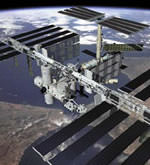
Image credit: NASA
The International Space Station made a pre-planned orbit shift to give the Italian Megsat 0 satellite a wide berth on Friday. The station was raised 1.8 kilometres over the course of 7 minutes using the Progress cargo ship which is currently attached. This is the sixth time the station has been repositioned since construction began – NASA originally thought it would have to happen twice a year, but it’s actually been less than that.
Science, maintenance and training for spacewalks was the focus of attention this week for the Expedition Seven crew of Commander Yuri Malenchenko and NASA International Space Station Science Officer Ed Lu as they complete their fifth week in space aboard the orbiting laboratory.
The station?s Microgravity Science Glovebox is back in action supporting hands-on experiments in a closed/controlled environment after researchers reset the unit?s computer to resume activity with the InSPACE experiment (Investigating the Structure of Paramagnetic Aggregates from Colloidal Emulsions), which began during the Expedition Six increment on the station.
Scientists hope to develop better fluids for systems that are routinely exposed to magnetic fields, such as automobile brake fluids and vibration damping systems. Experimenters also hope to use data from InSPACE to develop new applications such as vibration damping systems for buildings in earthquake-prone areas.
Earlier this week a faulty battery in the Zvezda living quarters module was replaced and the crew practiced techniques for conducting a spacewalk without the assistance of a third crewmember. Portions of the demonstration will be rescheduled due to a problem encountered when the water flow in Lu?s undergarment failed to work properly. The Extravehicular Activity team is evaluating the problem.
No spacewalk is planned for the six months the Expedition Seven crew is aboard the complex, but the on-orbit training exercise ? or dry run ? was designed to prepare the crew in the event an unscheduled spacewalk is warranted.
Earlier today, trajectory flight controllers planned, and then executed, a slight orbit-raising firing of the Progress resupply ship engines to position the ISS out of the path of an orbiting satellite:
http://www.megsat.com/html/megsat0.htm
The one-meter per second posigrade maneuver lasted a little more than 7 minutes and was conducted at 11:50 a.m. CDT Friday after three days of tracking confirmed the need for the burn. The result of the burn actually raised the station?s average altitude by about 1.8 kilometers. The closest approach to the station occurred at 3:55 p.m. CDT Friday. The maneuver was the sixth in the history of the ISS since construction began in November 1998. The ISS Program estimates that about two such maneuvers would be needed each year, but the actual number thus far is fewer than one each year.
Thursday, the crew gathered in the Destiny Laboratory to talk about their mission with WABC Radio?s ?Rambling with Gambling? show in New York City and KNX Radio in Los Angeles.
That followed Lu?s demonstration of the properties of flight in microgravity using a paper airplane and a small model of the Wright Flyer he brought along in honor of the Centennial of Flight activities of the Wright Brothers’ achievement. Preparations continue on track for the launch of a new Progress 11 cargo ship to the ISS June 8, which will dock to the station June 11, delivering more than 5,000 pounds of food, water and supplies for the crew on board.
Original Source: NASA News Release
